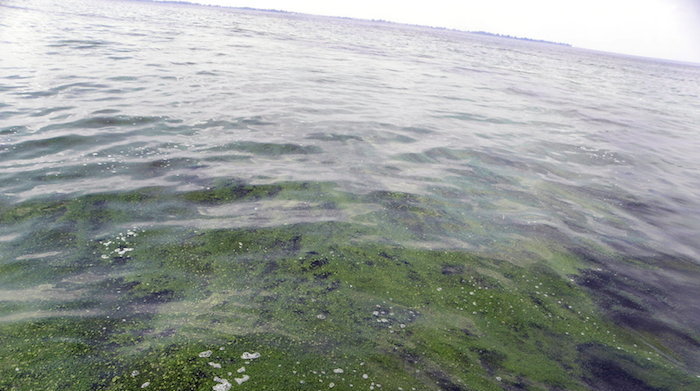
Persistent toxic algae blooms in Lake Erie are worrying local public officials. NOAA scientists predict this year’s bloom could be a near-record. Image: Karen Schaefer
By Karen Schaefer
On the eve of last year’s Toledo drinking water crisis, this year’s Lake Erie algae bloom is already growing fast. While Toledo officials say they’re better prepared than last year, some local politicians say more needs to be done.
SCHAEFER: Lake Erie Charter Boat Association president Paul Pacholski slows his boat near the Toledo water intake. He points to a brilliant green scum floating on the water’s surface.
PACHOLSKI: If you start looking at the water right now, you can see the harmful algal bloom, the microcystis starting to take hold.
SCHAEFER: NOAA scientists have predicted this year’s now-persistent toxic algae bloom could rival the one in 2011, that stretched all the way from Toledo to Cleveland. So far, wind patterns have kept the bloom from coming ashore and threatening drinking water. But it already fills more than half of the western basin. Cities like Toledo say they’re now much better prepared to treat the algae toxins. That’s due to investment in better treatment and detection systems, and new toxin

Ohio state representative Teresa Fedor, a Democrat from Toledo, says she wants more action from state officials on enforcement.. Image: Karen Schaefer
guidelines from the US EPA. But Ohio state representative Teresa Fedor of Toledo says she’ll hold state officials’ feet to the fire, should this year’s bloom once again poison her city’s drinking water.
FEDOR: I am putting the governor and my colleagues on record right now, that if this happens this year, I don’t want to say I told you so, I want to say you need to get down to business.
SCHAEFER: Fedor wants Ohio to commit more funds and personnel to enforcement of pollution run-off from Northwest Ohio farms.
Support for Karen Schaefer’s public radio series is provided by the Ohio Sea Grant College Program at Ohio State University.
